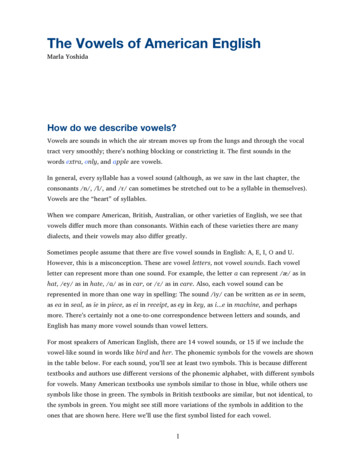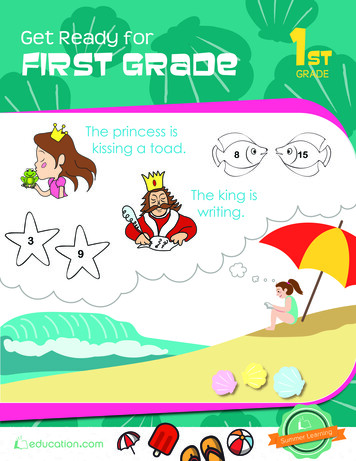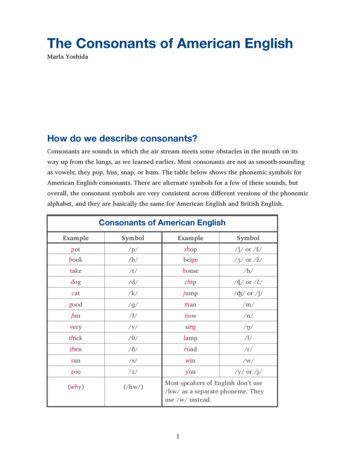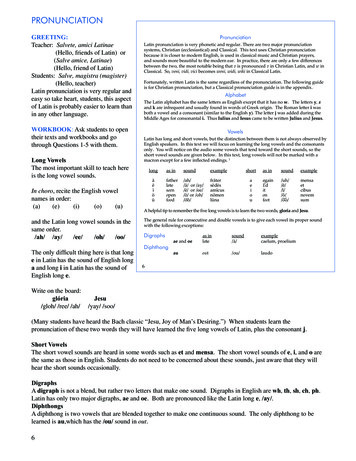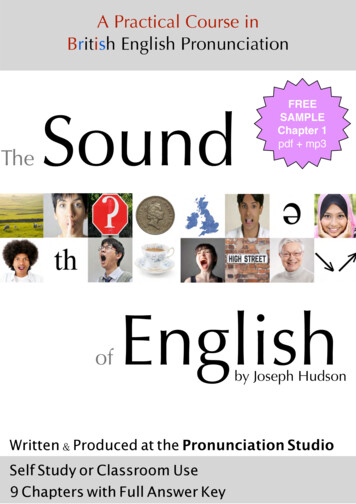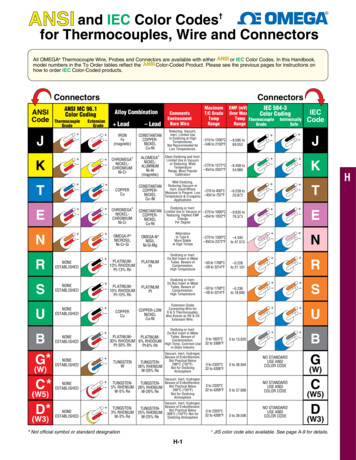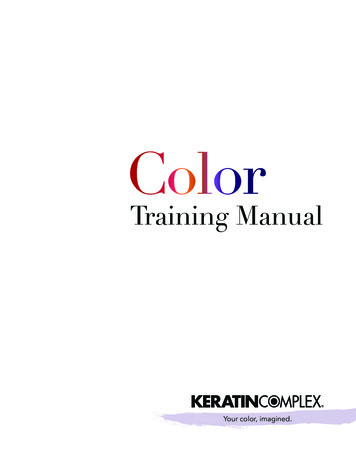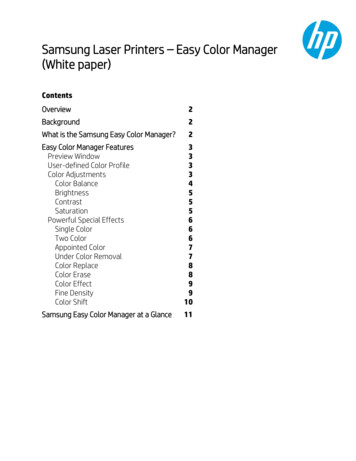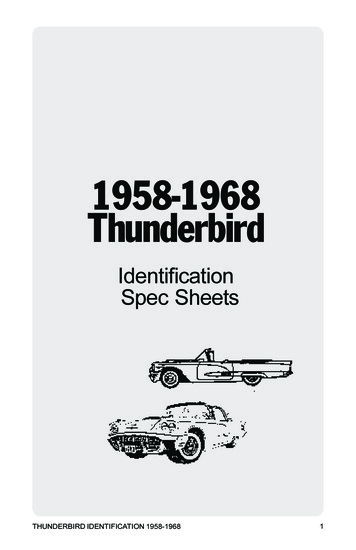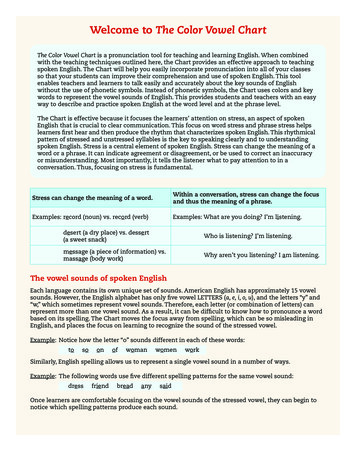
Transcription
Welcome to The Color Vowel ChartThe Color Vowel Chart is a pronunciation tool for teaching and learning English. When combinedwith the teaching techniques outlined here, the Chart provides an effective approach to teachingspoken English. The Chart will help you easily incorporate pronunciation into all of your classesso that your students can improve their comprehension and use of spoken English. This toolenables teachers and learners to talk easily and accurately about the key sounds of Englishwithout the use of phonetic symbols. Instead of phonetic symbols, the Chart uses colors and keywords to represent the vowel sounds of English. This provides students and teachers with an easyway to describe and practice spoken English at the word level and at the phrase level.The Chart is effective because it focuses the learners’ attention on stress, an aspect of spokenEnglish that is crucial to clear communication. This focus on word stress and phrase stress helpslearners first hear and then produce the rhythm that characterizes spoken English. This rhythmicalpattern of stressed and unstressed syllables is the key to speaking clearly and to understandingspoken English. Stress is a central element of spoken English. Stress can change the meaning of aword or a phrase. It can indicate agreement or disagreement, or be used to correct an inaccuracyor misunderstanding. Most importantly, it tells the listener what to pay attention to in aconversation. Thus, focusing on stress is fundamental.Stress can change the meaning of a word.Within a conversation, stress can change the focusand thus the meaning of a phrase.Examples: record (noun) vs. record (verb)Examples: What are you doing? I’m listening.desert (a dry place) vs. dessert(a sweet snack)Who is listening? I’m listening.message (a piece of information) vs.massage (body work)Why aren’t you listening? I am listening.The vowel sounds of spoken EnglishEach language contains its own unique set of sounds. American English has approximately 15 vowelsounds. However, the English alphabet has only five vowel LETTERS (a, e, i, o, u), and the letters “y” and“w,” which sometimes represent vowel sounds. Therefore, each letter (or combination of letters) canrepresent more than one vowel sound. As a result, it can be difficult to know how to pronounce a wordbased on its spelling. The Chart moves the focus away from spelling, which can be so misleading inEnglish, and places the focus on learning to recognize the sound of the stressed vowel.Example: Notice how the letter “o” sounds different in each of these words:tosoonofwomanwomenworkSimilarly, English spelling allows us to represent a single vowel sound in a number of ways.Example: The following words use five different spelling patterns for the same vowel sound:dressfriendbreadanysaidOnce learners are comfortable focusing on the vowel sounds of the stressed vowel, they can begin tonotice which spelling patterns produce each sound.14-20969 Color Vowel Chart Relayout CX1.indd 11/14/14 7:39 AM
Understanding The Color Vowel ChartGet to know each Color VowelEach color in The Color Vowel Chart represents a single vowel sound. Each sound has a color nameand a key word. For example, GREEN is the color name, and TEA is the key word. GREENrepresents the vowel sound you hear in both of those words: /i/. Similarly, BLUE MOONrepresents the vowel sound /u/, as in true, balloon and approve. Even though these words havedifferent spelling patterns, they share the same vowel sound, which we call BLUE.Identify the “color” of new vocabulary words and phrasesThe Color Vowel Chart allows us to describe any English word based on the pronunciation of theprimary stressed syllable in the word. Here, it is important to focus on a fundamental rule ofspoken English: each word has exactly one primary stressed syllable, and that syllable has astrong, lengthened vowel sound at its center. Using The Color Vowel Chart to assign a color tothat vowel sound, we can say that each word has exactly one color. One-syllable words contain one vowel sound (even if it contains more than one vowel letter).For example, soup is BLUE, bread is RED, and knife is WHITE. In multi-syllable words, only one of the syllables has primary stress. Stress makes thesyllable higher, louder, and longer than the other syllables.For example: education, classroom, biological In common phrases, one word will receive the focus stress. For example, See you later isGR AY, Let’s have lunch is MUSTARD, Nice to meet you is GREEN as is Have a nice weekend.When you hear or say a word or phrase, try to identify the color (vowel sound) of the stressedsyllable. For example, teacher receives stress on the first syllable, so this word is GREEN. Similarly,English receives stress on the first syllable, the sound of which is SILVER. Education, with stress onthe third syllable, is GR AY. She’s a student is BLUE. She’s studying biology is OLIVE. Please sit downis BROWN.Try it! A What color is each word or phrase?pencilpapercomputertypedeleteGood luck.See you later.(Answers: pencil RED; paper GRAY; computer BLUE; type WHITE; delete GREEN;Good luck. MUSTARD; See you later. GRAY )14-20969 Color Vowel Chart Relayout CX1.indd 21/14/14 7:39 AM
The Shape of the ChartThe shape of the Chart mirrors the shape of the vocal tract, with GREEN representing the high frontvowel /i/, OLIVE representing the low central vowel /a/, and BLUE being the high back vowel /u/. Theshape helps learners visualize the relationships between the various vowel sounds and how they areformed in the mouth, eliminating the need for descriptions such as low, central, or high.What are the “y” and “w” for?There are two types of English vowels: moving vowel sounds andnon-moving (still) vowel sounds. Moving vowel sounds move in one oftwo directions: toward “y” or toward “w.” Y-moving vowels movetoward the “y” at the top left corner of the Chart (as heard in GRAYand WHITE), while w-moving vowels move toward the “w” in the topright corner (as heard in ROSE and BROW N). The “y” and “w” thereforeauburnidentify the direction of the vowel’s movement. You can help yourdogstudents notice this movement by saying each sound and illustratingthe movement with your hand on the Chart. The chart belowsummarizes the still and moving vowel sounds in English.The “y” and “w” at the top of the Chart serve another purpose: namely, they remind us and our learners aboutvowel-to-vowel linking, both within words and between words, something we hear, but don’t see in writing.Within words:variYation, situWationBetween words:seeYit, his material is licensed to the U.S. Department of State to be printed and distributedin compliance with the established agreements through the year 2015.K. Taylor & S. Thompson2009, 2012. All rights reserved.What is the “r” for?The Color Vowel Chart enables you to use a visual approach in teaching r-controlled vowels. R-controlledvowels are vowels that, when followed by an “r,” have a modified sound. First, say the word and hold the vowel sound that precedes the “r.” Then locate the sound of thestressed vowel on the Chart. For example, the word car would start at OLIVE. Point to OLIVE onthe Chart. Then, using your hand as a guide, glide that sound up through PURPLE to the watermark “r” justabove the Chart and say the rest of the word: caaaaarrrrrr. This movement illustrates the actualmovement of the tongue and jaw while making the sound.Try it! A Say each word slowly, paying attention to the color of the vowel before you start pronouncingthe “r” sound.What color is it? heretherecarcaresorryblurry(Answers: here GREEN A PURPLE; there RED A PURPLE; car OLIVE A PURPLE;care RED A PURPLE; sorry OLIVE or AUBURN A PURPLE; blurry PURPLE)IPA �MUSTARDMOVING VOWELSThe sounds at the left are all moving vowels (tense vowels,diphthongs, and glides). That is, the jaw and/or tongue movefrom one position to another in order to produce these vowelsounds. The “y” and “w” featured in the Chart indicate thedirection of the movement in these vowel sounds.NON-MOVING VOWELSThese are all non-moving (still) vowels (lax vowels andmonophthongs). That is, each sound is produced with asingle non-moving tongue-jaw position.PURPLEWOODEN14-20969 Color Vowel Chart Relayout CX1.indd 31/14/14 7:39 AM
How to Use The Color Vowel Chart in the ClassroomStrategy #1: Get to know the color vowels. Show The Color Vowel Chart to the class. Point to each color,and say the color name and the key word. Make sure you are producing the same vowel sound for bothwords, such as BLUE MOON. With beginning students, introduce and practice just a few colors at a time.Strategy #2: Study by color. Create a Color Vowel Word List or word wall in the classroom to categorizeand review words and phrases according to their stressed vowel sound. Identify the color of a givenword or short phrase, and review it alongside other words of the same color. Have students create theirown word lists in their notebooks and write words in the boxes according to the sound (color) of thestressed vowel. Together, read the words in each box, noticing their shared stressed vowel sound.Note: The color of a phrase is based on which word in the phrase receives the most stress, the focusword. For example, in the phrase a bunch of bananas, the words bunch and bananas both receive stressbut bananas receives more stress because it is the last content word in the phrase.Try it! A Look at the Color Vowel Word List. Say each color and key word and the vocabulary words andphrases below. Then have students repeat, emphasizing the stressed vowel sound.Color Vowel Word ListGREEN TEApeachescheesebeanszucchinia jar of peanut butterpapayaice creamriceSILVER PINchickenfisha dozen shrimpa carton of milkoiloystersGR AYmangoesa box of raisinsa sack of potatoesDAYgrapesa dozen eggsgrapefruitRED DRESSa head of lettucea loaf of breada bottle of ketchupapplesradishescabbageBLACK CATyamsa bunch of bananasturnipsa burgerWHITE TIEpineapplelimesTURQUOISE TOYcookiessugarPURPLE SHIRTOLIVE SOCKBLUE MOONtunasoupjuiceWOODEN HOOKpuddinggoat cheesesodaA CUP OF lmondsROSE COAToatmealcoconutmilkBROW N COWAUBURN DOGsausageorangesstrawberriesTry it! A Add these words and phrases to the Color Vowel Word List.coffee, cream, a jar of pickles, toast, pancakes, muffin, syrup, soy sauce, a bunch of carrots,celery, pepper, butter, yogurt, hamburger(Answers: coffee AUBURN or OLIVE*; cream GREEN; a jar of pickles SILVER; toast ROSE; pancakes BLACK; muffin MUSTARD; syrup GREEN or SILVER or PURPLE*; soy sauce TURQUOISE; a bunch ofcarrots RED or BLACK*; celery RED; pepper RED; butter MUSTARD; yogurt ROSE; hamburger BLACK. *Pronunciation varies depending on one’s national, regional, or cultural background.)Note: Compounds or set phrases are typically stressed on the first word and treated as one word whetherthey’re written as one word (e.g., hotdogs, grapefruit, blueberries, pancakes) or two words (e.g., peanut butter, goat cheese, ice cream, soy sauce).Strategy #3: Focus on word forms. Vocabulary development means knowing not just a single word,but the various forms that a word can take. For example, the word photograph is related to photographerand photographic. In English, a different form of the word may stress a different syllable. When teachingword forms, draw students’ attention to the color of the stressed syllable in one form of the word andcompare it to the color of its related forms.ROSEOLIVEBLACKphotograph (or photo)photographerphotographicTry it! A What color is each word? Underline the stressed vowel and identify its (Answers: educator RED; educational GRAY; electric RED; electrician SILVER)14-20969 Color Vowel Chart Relayout CX1.indd 41/14/14 7:39 AM
Introducing The Color Vowel Chart at Different LevelsBeginning through intermediate learnersWe recommend using The Color Vowel Chart with beginning learners. Most languages do not use stressthe same way English does, so helping learners focus on stress is essential to a strong start in speakingand understanding English.Sample Lesson:Preparation: Select common words that have one of the following sounds in the stressed syllable. Here arepossible words:º GREEN: me, seat, teacher, tree, feet, teeth, meet, meal, readº OLIVE: hot, box, hospital, doctor, knock, clockº BLUE: shoe, student, afternoon, spoon, food, noon Draw a blank Color Vowel Word List on the board. Have students draw a blank Color Vowel Word List in their notebooks, or provide copies for yourstudents.Lesson Steps:1. Show students The Color Vowel Chart. Say Tree. Tree. Tree. Teeeea-cher, teeeeacher, teeeeacher. (Use picturesor drawings of each word if needed.) Exaggerate. Use gestures or a rubber band to show thelengthening of the first vowel sound. Can you hear the same sound? Eeeeeee Seat. Seat. GREEN TEA,seat. Now pointing to the Chart. GREEN TEA, tree, GREEN TEA, teacher, GREEN TEA, seat. [Continueuntil students seem to understand that you are drawing their attention to the stressed vowel soundin each word.]2. Repeat the words tree, teacher, and seat as you write those words in the GREEN section of the ColorVowel Word List on the board.3. Have students repeat the words on the list as you have modeled, using gestures to indicate thelengthening of the stressed vowel sound in each word.4. Have students write the words on a Color Vowel Word List in their notebooks.5. Repeat steps 1–4 when you introduce new words.Key Points: Make a Color Vowel Word List on the wall and add new words to it as you study newvocabulary. Have students keep their own word lists in their notebooks. Be patient. It will take students time to be able to correctly identify the color of thestressed vowel. In the meantime, they are learning that it is important for them to listenfor and begin to produce stress in spoken English.14-20969 Color Vowel Chart Relayout CX1.indd 51/14/14 7:39 AM
Introducing The Color Vowel Chart at Different LevelsHigh intermediate through advanced learnersSample Lesson:Lesson Steps:1. Show students The Color Vowel Chart. Say each color and key word, and have students repeat afteryou.2. Invite students to identify the featured vowel sound in each color and key word. Make sure studentsare able to identify the featured vowel sounds before you move on in the lesson.3. Facilitate discovery by using the days of the week. Have students identify the color of the stressedsyllable in each word. Don’t write the words on the board—the focus here is on listening to the vowelsound in the stressed syllable. Monday and Sunday, for example, are both MUSTARD. Tuesday is BLUE.Wednesday is RED.4. Write (on the blackboard) and say each of the words below one by one. Have students repeat andthen write (in their notebooks) each word in the Color Vowel Word List that corresponds to the vowelsound in the stressed syllable of the word or phrase. Students should work in pairs to decide whereto place the word. The teacher should stand back during this activity, speaking only to provide modelpronunciation. (1-syllable words) good, best, nice, sure, new (2-syllable words) super, superb, awesome, skillful, friendly (3-syllable words) amazing, fantastic, wonderful (4- and 5-syllable words) approachable, unbelievable, out of this world5. To conclude this lesson, give students a small piece of paper each and have them write down onenew word or phrase that they personally find difficult to pronounce. Collect the pieces of paper. Pickone word and write it on the board. Model the pronunciation of the word, and have students repeat.Have the class identify the stressed syllable, and underline the stressed vowel sound in the word onthe board. Then have students identify the color of the stressed vowel sound. Do this with a few of thestudents’ words at the end of each class, each time reminding students to write any difficult words intheir Color Vowel Word List.Key Points: Explain that you will use the Chart on a regular basis as an easy way to talk about thepronunciation of a word. For example, when a student comes upon the word receive in atext and asks you how to pronounce it, you might say “that word is GREEN; listen to howI say it,” then model the word and have the student repeat it back: “receive, GREEN TEA,receive.” Make a word wall and add new words and phrases to it as you study new vocabulary. Have students keep their own word lists in their notebooks. Post the Chart in your classroom and refer to it as needed. It will become a tool for helpingstudents pronounce words and phrases correctly and can be used with any kind of lesson.14-20969 Color Vowel Chart Relayout CX1.indd 61/14/14 7:39 AM
Understanding The Color Vowel Chart Get to know each Color Vowel Each color in The Color Vowel Chart represents a single vowel sound. Each sound has a color name and a key word. For example, GREEN is the color name, and TEA is the key word.GREEN represents the v
